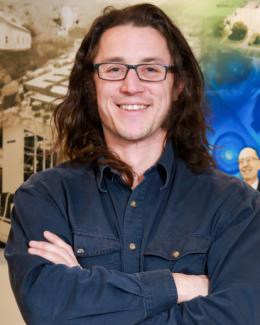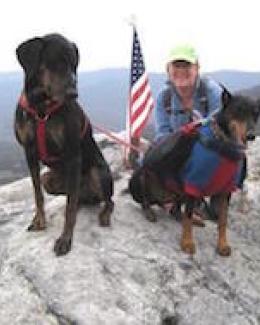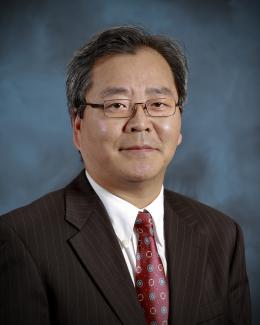Undergraduate student Caridad Estrada from Florida International University spent 10 weeks at ORNL in the summer of 2022 working on mercury remediation technology as part of a DOE internship program. Credit: Melanie Mayes/ORNL
Environmental scientists at the Department of Energy’s Oak Ridge National Laboratory have recently expanded collaborations with minority-serving institutions and historically Black colleges and universities across the nation to broaden the experiences and skills of student scientists while bringing fresh insights to the national lab’s missions.
The partnerships are supported by special programs at DOE, including the Office of Science Biological and Environmental Research Program’s Research Development and Partnership Pilot projects, or RDPP; the Office of Science’s Reaching New Energy Sciences Workforce projects, or RENEW; the DOE Office of Environmental Management’s Minority Serving Institution Partnership Program, or MSIPP, and other internships.
“Addressing environmental challenges in an equitable manner requires a broad pool of talent and perspectives. These collaborations give us an opportunity to connect with students from historically marginalized communities and enables their access to the unique capabilities and expertise available at the national laboratories. The result is beneficial to ORNL’s science mission, our staff members and to the students’ professional development,” said Eric Pierce, director of the ORNL Environmental Sciences Division.
Georgia State University: Broadening participation in (sub)urban watershed science in the Southeast
At Georgia State University, an RDPP project with ORNL will provide training and networking opportunities for master’s students in the university’s geosciences program. Two students are expected to spend several weeks at ORNL this summer as part of the program, with more expected as the collaboration continues over the next two years. The program will help ORNL scientists gain insight into urban environments in the U.S. Southeast, where Atlanta-based GSU has an active research program and expertise. deep knowledge.
As part of the project, GSU faculty will also travel to ORNL to discuss research and establish networks for future collaborations, and ORNL scientists will travel to GSU to speak with students about internships and jobs. GSU will also help foster relationships between ORNL and community groups advocating for environmental justice in Georgia, said Sarah Ledford, assistant professor and principal investigator for the partnership at GSU.

“As a minority-serving institution and a department without a [doctoral] program, we play a key role in training the next generation of scientists, as we have a focused commitment on masters-level education,” Ledford said.
By building relationships at many levels — undergraduate, graduate, principal investigator and community — ORNL will gain access to key expertise in urban systems, Ledford added. One of the students will focus on evaluating differences in resilience and recovery of stream metabolism to storms across land use gradients, including urban areas. Another will focus on investigating the transport of metals from brownfield sites to streams and rivers, a key concern in understanding how historical land uses impact current stream health.
“I’m excited to bring a renewed focus on training [graduate] level students and to think about the role such graduates could play as future employees at ORNL,” Ledford said. “In addition, I’m excited for the potential of expanded research with ORNL in urban areas, especially on urban watersheds in the Southeast with a focus on research that addresses environmental justice.”
Marie Kurz, hydrogeochemist and ORNL’s lead for the project, said the program provides “an excellent opportunity to increase the visibility of ORNL and DOE with underrepresented students who otherwise have limited exposure to what DOE does and the national labs as a career option. We are supporting funded opportunities for these students to collaborate with ORNL scientists from the Watershed Dynamics and Evolution Science Focus Area and other programs. At the same time, we’re able to strengthen connections with the GSU faculty and leverage their unique expertise and perspectives in urban watershed science, an area of growing interest for DOE.”
Lincoln University of Missouri: Training a diverse STEM workforce to measure and model energy, water and carbon budgets
In a multi-year RENEW project, Lincoln University of Missouri graduate students will spend time at ORNL and will also conduct research at the Missouri Ozark AmeriFlux, or MOFLUX, site, a highly instrumented ecosystem overseen by the University of Missouri. Both sites are supported by DOE as part of the Terrestrial Ecosystem Science Scientific Focus Area led by ORNL. The students will conduct hands-on research and receive training as they learn to measure and model water, energy and carbon ecosystem fluxes.
The LU students will focus on forest ecosystem evapotranspiration, a key process that draws water from the land to the atmosphere via plants and soils. The process links water, energy and carbon cycling equations, said Sean Zeiger, assistant professor of forest hydrology and watershed management and the project’s principal investigator at the university.

The students will spend time at ORNL analyzing the data they have collected and will learn how to model ecosystem processes to better understand and predict environmental trends and impacts.
“As an early career scientist, I look forward to watching these highly motivated students become environmental stewards, philanthropists, scientists and teachers; to building partnerships with world-class scientists at the University of Missouri and ORNL; and to nurturing their personal growth through teaching and professional development that the program offers,” Zeiger said.
“Resources from this DOE award will allow me to share what I’ve learned with students at LU at a level that I still haven’t fully wrapped my mind around,” Zeiger said. “I’m also grateful for partnerships with the University of Missouri and Jeffrey Wood at MOFLUX, and ORNL scientists Maggie Davis, Lianhong Gu, Melanie Mayes, Benjamin Sulman and Anthony Walker.”
Mayes, leader of ORNL’s Biogeochemical Dynamics group, said, “As a first-generation college student from rural Missouri, I am so happy to share my experiences at ORNL with Lincoln students. They will tour some of our wonderful facilities and meet with diverse groups of technicians, postdocs and research scientists. This opportunity will help them envision themselves in their future science careers.”
Florida International University: Engineered multilayer amendment technology for mercury remediation on the Oak Ridge Reservation
Florida International University has a long history of collaboration with ORNL. Under a DOE-FIU cooperative agreement for the past 25 years, FIU’s Applied Research Center has worked with national laboratory scientists, including on the Oak Ridge Reservation, in the areas of site decommissioning, deactivation and remediation under DOE’s Office of Environmental Management . The DOE EM Fellows program, a workforce development component of the agreement, has supported 21 FIU STEM students conducting research during internships at ORNL since 2007.
In the summer of 2022, DOE fellow and FIU undergraduate Caridad Estrada worked with ORNL’s Alex Johs and other scientists in the lab’s Biogeochemical Dynamics group. The project’s goal is to develop sustainable mercury sorbents for East Fork Poplar Creek, a waterway with legacy contamination issues, that flows through the Oak Ridge Reservation.
“Estrada’s experience at ORNL gave her a window into a national laboratory research environment, mentoring with leading biogeochemistry experts, and the opportunity to collaborate with even more institutions already networked with ORNL such as Duke University and Northwestern University,” said FIU senior research scientist John Dickson.

Dickson, who also was a postdoctoral researcher at ORNL in the mercury remediation area, said a personal motivation for the project stems in part from the opportunity to transition basic science into applied science. “We get to conduct foundational science as we develop materials for remediation, and then apply it in real life to help clean up the environment,” he said.
The DOE fellows program “gives us the opportunity to open doors for those extraordinary students who have the spark for science,” Dickson said. “In Caridad’s case, she had zero experience in the laboratory when starting the program, and now she has become an expert and will likely go on to an Ivy League school for her graduate studies.”
The DOE-FIU workforce development program “is also a tremendous opportunity for us to recruit minority FIU STEM students into the program and train them in a lab environment where they can acquire the skills and experience needed for them to succeed in a variety of ways,” Dickson added. “About 97% of the students in our program end up employed by local companies, national laboratories or at some level within the federal government.”
University of California, Merced: Manganese and iron-oxide-modified activated carbon for the remediation of mercury-contaminated sediment and water
At the University of California, Merced, mercury is a regional challenge that student and faculty researchers have been tackling for several years. Mercury was used to extract gold during the Gold Rush in California, and the element was also mined at the New Almaden site, at one time the second-largest mercury mine in the world near today’s Silicon Valley.

In its MSIPP collaboration with ORNL, UC Merced students will test mercury remediation technology consisting of activated carbon coated with manganese oxide. The technology seeks to discourage the transformation of mercury into the neurotoxin methylmercury by using manganese to limit methylation. The absorbent carbon material helps keep mercury in place in soil sediments rather than being flushed into the stream, said UC Merced’s Peggy O’Day, professor of environmental geochemistry and the project’s PI.
Johs is the ORNL PI for this project, which began in 2018 as the students performed initial lab experiments. Johs recently shipped East Fork Poplar Creek sediments from ORNL to UC Merced for soil column experiments. Both undergraduate and graduate students are expected to visit ORNL and conduct field trials as part of the program.
O’Day said it is ORNL’s well-regarded expertise in mercury that led her to pursue collaboration with the lab and MSIPP funding. She noted that it was ORNL scientists who led the research that identified the genetic underpinnings of how inorganic mercury converts to toxic methylmercury.

“Mercury is a complicated contaminant,” O’Day said. “There’s no off-the-shelf fix. Just like radionuclides, you have to think about context — the form of the contaminant, where it is, what the risk factors are and knowing that you’ll never completely get rid of it. It’s valuable for these students, a mix of environmental scientists and engineers, to realize that complexity.”
“Students get an in-depth experience in the program, particularly working with national laboratory facilities,” O’Day said. “Most of our undergrads don’t even know that national labs exist or what they do and who works there. They’re amazed to find out the breadth of basic science that goes on at the national labs, as well as the applications that come out of the work. They’re often surprised at the range of scientists and engineers who work there, and it expands their knowledge of the many pathways for a science career at various levels.”
Commenting on both the FIU and UC Merced collaborations, ORNL’s Johs said working with “talented and motivated students and passing on knowledge to the next generation of scientists is a highly rewarding experience.” Helping resolve the mercury challenge is exciting, he said, because of the complexity and urgency of the problem. “Mercury contamination is a global concern and a long-term issue, as it can remain in the environment for many years, bioaccumulate up trophic levels, enter the food chain and pose a risk to human health. The environmental and human health risks make it essential that we develop effective strategies for remediation.”
O’Day said the MSIPP program with ORNL “encourages our students, and especially our minority students by sending the message that DOE and the national laboratories are places they should be thinking about as career pathways. The idea that they belong at the national labs makes a big impression. I hope that DOE continues to support the program and expands it to even more science areas, because I think it’s having a big impact on students.”
Some of the other projects in which ORNL environmental scientists are collaborating with MSIs and HBCUs include:
Biological and Environmental Research RDPP projects:
- Tennessee State University—Simulating greenhouse gas emissions of a peatland ecosystem under global warming and elevated CO2 at the SPRUCE experimental site
- Tennessee State University—On improvement of soil organic carbon modeling and simulation via integrated deep learning and data assimilation approaches
- New Mexico State University—Hydro-EKG: In-stream streaming-potential electrical monitoring of the lifeblood of watersheds during disturbance
- University of Minnesota Duluth—Multisystem feedbacks from a changing climate: Do altered hydrological dynamics control vadose zone carbon nutrient cycling and storage in shallow aquifer systems?
- University of Memphis—Building partnerships for development of sustainable energy systems with atmospheric measurements
- Central Michigan University—Expanding collaborative capacity to address climate resiliency in the Great Lakes Region
Environmental Management MSIPP project:
- New Mexico State University—Coupling direct and indirect characterization methods for mercury transport and surface water-hyporheic exchange.
UT-Battelle manages ORNL for DOE’s Office of Science, the single largest supporter of basic research in the physical sciences in the United States. DOE’s Office of Science is working to address some of the most pressing challenges of our time. For more information, visit https://energy.gov/science. — Stephanie Seay








